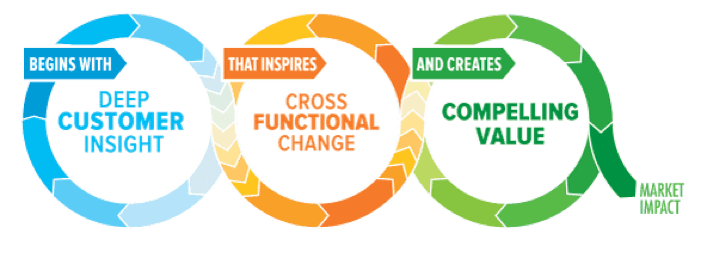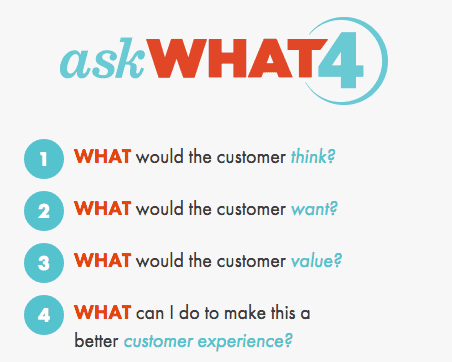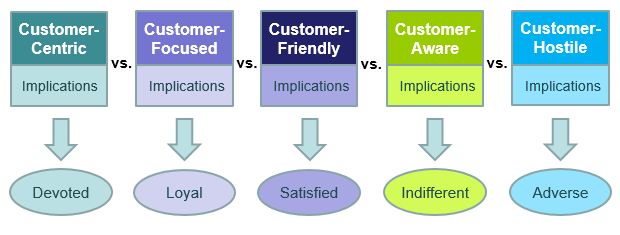One of the biggest challenges for business leaders is deciding where to invest, when and how much. As they look to achieve or maintain market leadership they are constantly striving to find the next market offering that drives exponential growth, market differentiation and customer delight.
There is often no shortage of ideas. The challenge is framing and prioritizing; identifying the idea or concept that will be most relevant and be recognized as delivering the most customer value. There are always multiple ideas competing for limited resources with global competitors moving faster across local markets, increasing time-to-market pressures. Balancing value creation with time-to-market can make the difference between new product success and failure.
Framing Ideas
One of the first steps in identifying high potential ideas is to take the time early in the filtering process to frame ideas from the customers’ view point. Spending time discovering and capturing customers’ day-to-day activities/challenges helps teams describe how new ideas align to customer needs and improve their experiences. There are 4 steps that drive increased success as companies consider new ideas. They include:
- Forming small cross-disciplinary teams:
Small cross-disciplinary (or cross-departmental) teams should be formed to participate in the ideation and prioritization process and assigned specific ideas to frame. These joint teams should include staff from Strategy, Marketing, Product, Engineering, Finance, Sales, Customer Service and Legal. The formation of cross-disciplinary teams leads to richer brainstorming and idea definitions as teams leverage more diverse and robust experiences and talents. As these teams participate early in the new product process they provide a broader understanding across the business of the potential of new offerings and the customer challenges they address. This participation creates a “common purpose” that encourages early collaboration and cooperation vs traditional siloed interactions. Teams should stay together as ideas move through the vetting process and on to design and delivery. This will help drive momentum and a deeper understanding within departments as team members serve as advocates and provide additional clarity based on their knowledge and insight. - Spending time with customers:
The best way to frame ideas is to spend time with customers in their environment, interviewing and studying behavior in order to understand daily activities, challenges and needs. This exposure and insight enables teams to more effectively describe the idea through customer stories and scenarios, expressing how it will benefit the customer. These early insights and descriptions form a customer-based foundation that will continue to be built upon as the idea progresses through the decisioning process (and on through design, development and delivery …).
- Using design early and often:
The use of creative design techniques should be leveraged during the idea definition and selection stage to help business colleagues visualize the potential of ideas early in the filtering process. These techniques include illustrations, story-boards and rudimentary prototypes, and should be used in an iterative fashion as ideas progress through the review process. Visual aids strengthen the story and help colleagues better understand the intent of the idea and how it benefits the customer (and the business). - Creating and refining Value Factors:
During the prioritization stage, teams should establish or refine business and customer value factors that form the basis for analyzing the potential of ideas based on their level of factor alignment. Identifying value factors and weighing ideas against these measures provides a more objective and structured approach to the decisioning process. Although it’s not completely scientific, it provides a more systemic approach to comparing and analyzing the early potential of ideas. This helps teams navigate decisions that are subjective and based on emotion (pet projects).
Initial idea prioritization can be completed quickly, with just a couple days of research, framing and team presentations.
Increased customer and expert research drives deeper insights and definition as teams move through the next iterations of the ideation process. During these iterations, teams should continue to leverage design, creating more in-depth illustrations and functional prototypes to provide additional clarity regarding new offering capability and potential. Prioritization iterations should continue until 2 or 3 ideas remain.
As prioritization narrows the idea pool, increased customer research and positioning will help cross-business teams understand early in the delivery process how new products address customer needs … preventing extended design and development timeframes. Establishing a deep understanding early will help drive meaningful use cases that will inform design and development, reducing rework and delays.
Harnessing Technology
Technology is constantly evolving and has often served as a catalyst for market disruption and incremental value creation. Companies that harness new technologies to improve operational efficiencies and create new, compelling customer offerings often leap-frog the competition and redefine industries. As new ideas are framed and vetted, teams need to ensure they include a focus on how technology can and should be leveraged in designing, delivering and supporting new offerings.
Delivering Enough Value
As new products move through delivery phases trade-offs often occur as teams experience unexpected challenges. These challenges often put the budget and delivery schedule at risk. Extended timeframes often result from unanticipated complexities, increased effort or increased scope causing initiatives to exceed budget – time and resources. Delivery teams mitigate design and development challenges using the three levers of time, budget and scope.
Quite often one of the first levers teams consider as they mitigate delivery challenges is “scope”; analyzing … is there functionality/content that can be cut that will allow the team to get back on track (schedule and budget). They often focus on scope as they consider the second lever – budget (i.e. additional staffing/resources); analyzing … can additional staff help without causing additional delays as current team members bring new staff up-to-speed (if supported by the budget). Maintaining a customer focus as these tradeoffs are considered is critical. Delivery teams need to continually confirm whether current scope is still meeting the original idea customer/market objective … delivering enough differentiating value. Quite often scope takes the majority of the hit to stay within budget and delivery timeframes, this practice can have a dramatic impact on the usefulness and usability of new offerings – impacting customer value.
Maintaining a Balance
Maintaining a balance between value creation and time-to-market is a true sign of a team that is in-tune with customer needs and operations – continually questioning whether the offering is useful enough to create compelling differentiation and offered in a timeframe that meets customer business goals/needs. If too much scope is cut, the new offering may no longer be useful (i.e. misses the mark – one of the main reasons 75% of new offerings fail). If the offering is delivered too late, the company may miss the customer’s business window (i.e. budget, technology or sales cycle) or fail to be first to market.
New product success occurs when a new offering is robust enough to delight customers and timely enough for customers to effectively leverage its capabilities to achieve their business goals … creating a new offering that is relevant, differentiates and drives top-line growth … Balancing value creation and time-to-market …







